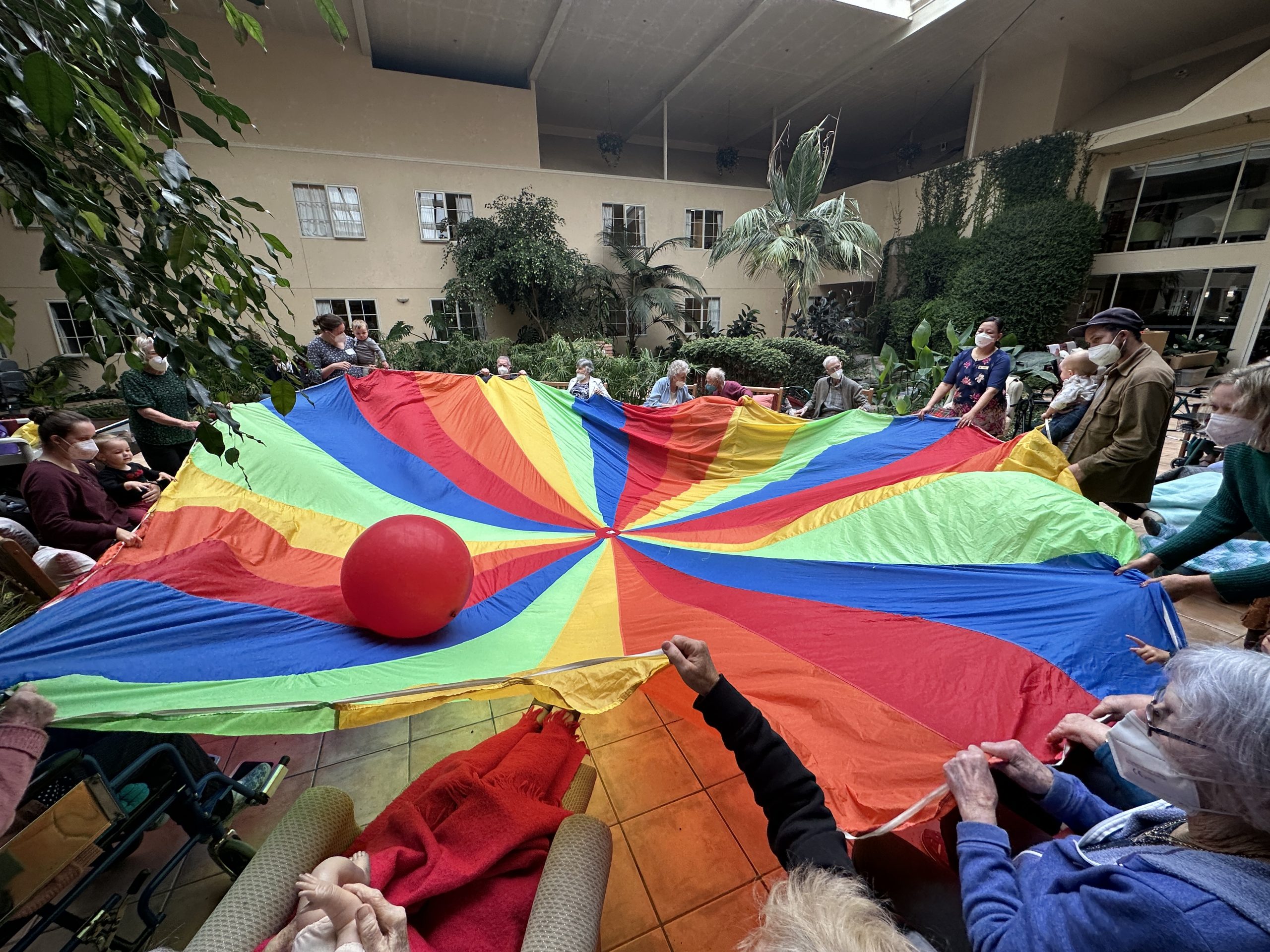BILL OF RIGHTS FOR PLAY
All players are equal or can be made so.
Novelty is more fun than repetition.
Rules are negotiable from moment to moment.
Risk in pursuit of play is worth it.
The best play is beautiful and elegant.
The purpose of playing is to play, nothing more.
– Joseph W. Meeker.
Twenty-three years ago, I was invited to conduct a Musical Play session with children from my music school and residents at Kauri Lodge Retirement village in Christchurch. A little boy crawled over to a woman Clara Fairgray, aged a hundred years. He reached up to her and stood for the first time. Everyone was watching, excited by Tom’s motivation to stand. Seeing the expressions of pride on everyone’s faces and their obvious enjoyment, convinced me that I had to keep going with this Intergenerational Musical Play programme.
I started with a group of parents and children aged up to two years. This programme continued for nine years and beautiful friendships developed between generations. Tom took his first steps over to Clara. One day he brought a large soft ball to music. He looked at Clara, smiled and deliberately kicked the ball to her. She stood unaided turned her walking stick upside down like a hockey stick and whacked the ball back to Tom. A wonderful, interactive game developed between the two, with much cheering from the residents, children and parents. Tom and his mother also started visiting Clara during the week and Clara told me that Tom and his family gave her a sense of purpose and reason for living. She lived until she was 103 and Tom was three when she died. A beautiful interactive photo of them both playing the drum together was on the cover of Sound Ideas Volume 6 Number 2 May 2003 Musical preferences-musical journeys through life Canterbury Studies in Music Education.
Last winter I was visiting someone in a retirement village. I noticed a sad looking woman in a wheelchair sitting outside with a younger woman in the last patch of sunshine. On the wheelchair tray was a box of chime bars. I couldn’t resist. I went over, smiled at them, opened the chime bars and played the woman a little musical question. She took the beater and played me an exquisite little musical answer that resolved on the note C. She looked straight at me and gave a smile as she passed me the beater. We had a musical conversation that was so musical, playful, with much use of turn taking, matching rhythmic patterns, pauses and a wonderful sense of improvisation. After she had put the beater down to indicate that she had finished, her daughter told me that her mother had Dementia, couldn’t talk, and often seemed locked in her world. She was very moved to see and hear how she could communicate musically and said that this was the most engaged her mother had been for some time. She asked many questions about how and why the music worked and was excited about ways that she and the staff could initiate such interactive musical play with her mother.
This experience motivated me to contact the manager of Ryman’s Ngaio Marsh Residential Home about establishing a weekly Musical Play programme for their residents, together with families from my music school. The manager and staff were very excited about this idea. The aim of each music session is to give everyone a rich, predictable, sensory musical play session, opportunity to play together, to use narrative and instructional songs to keep everyone connected in the moment and to develop a sense of nurturing music community.
We started the music sessions in a beautiful big atrium. The residents were clearly delighted to see the children. We began with a ‘Hello Song,’ familiar action songs and nursery rhymes. Everyone came together in a circle through use of a large stretchy rainbow ring/co-operband. The sensory experience of bouncing the ring, moving it forwards and backwards, side to side together helped to develop good listening, timing, ability to follow a sequence of actions, and to establish a strong sense of synchrony. I sang an instructional song for the children to come and get a maraca. Everyone was given a maraca to play for a range of catchy music and dances. This was followed by a slow predictable action song in which every player stretched up high, brought their maracas down low, moved them from side to side, around and around, hid them behind their back and stopped on cue for the sung instruction …’now get ready to stop’. We finished the session with a traditional folk song using a large, floaty, colourful parachute that everyone could hold onto. We use sign language for the song “Music Time Has Finished Now”, followed by a Goodbye Song. Residents are aged from late seventies through to one hundred years. The children are aged up to three years. The first music session was clearly a success, as children became accustomed to the new setting, watching and starting to interact with the residents. Some residents preferred to sit back and watch, but others wanted to join in the play. One woman told me that it was about sixty years since she had been with children or held a child’s hand, as she had no grandchildren. She often becomes emotional watching them and joining their spontaneous actions and play.
At Christmas time we had a special Christmas music session. We began with our usual song routine then I introduced a very large red balloon. We threw the balloon in time to a beautiful instrumental Christmas medley of songs. One man who always looked quite frail, stood, caught and threw the balloon with such strength that and it sailed high into the air right across to the other side of the atrium where it was caught by another man who threw it to a child, who promptly threw it back. It was very moving to experience the joy, laughter and sense of playfulness as the balloon was thrown and caught by so many of the residents, parents and children. When I sang the instructions for children to come and get their jingle bells, all the children started giving the bells to the residents. This instructional song provides predictability, helping children to know when to get their own instrument, give them out to the residents, cues them to collect these instruments and to put them back at the end of the activity. One little three-year-old noticed that one man couldn’t hold his jingle bells very well, so she curled his fingers around it and stayed right beside him demonstrating the actions. At the end she patted his knee, gently took his jingle bells, and put them away. When we finished our Christmas session everyone was smiling and singing along to our selection of Christmas carols. Away in a Manger was a deeply moving experience for everyone as we watched the children being rocked and cuddled by their parents.
This year our numbers of residents has increased, and we now regularly have up to thirty residents at every session. Friendships have formed. One beautiful child with Down syndrome goes around each week spontaneously shaking hands with residents or giving them a cuddle. He delights in being the star, demonstrating actions of songs, or initiating new activities such as using the sign for each animal in the song ‘Old MacDonald’ or blowing kisses at the end of the Goodbye Song.
A little girl enchants everyone with her dancing. Yesterday she ran on top of the huge parachute. Everyone was leaning forward watching and moving together as we gently undulated the parachute to my narrative song about her dancing actions. I noticed that everyone was smiling, everyone was in synchrony regardless of age or ability, everyone was emotionally connected, holding the parachute and playing together in the moment. The little girl was clearly empowered as she listened to the song about her, felt the rhythmic support, the gentle sensory flow of the colourful parachute and saw the smiles of delight on everyone’s faces as she danced in the middle.
Every week I see how Musical Play is bringing about changes and development in relationships, confidence, timing, memory, energy, risk taking, playfulness, self-understanding and growth. Staff are helping, becoming more involved as they see the positive changes taking place in their residents. Parents are staying behind to talk to the residents, children and residents are playing together in the environment, Musical Play helps people to become emotionally connected, mentally and physically playful, it develops a sense of wonder and creativity and brings generations together in the most moving, remarkable ways.
By Julie Wylie
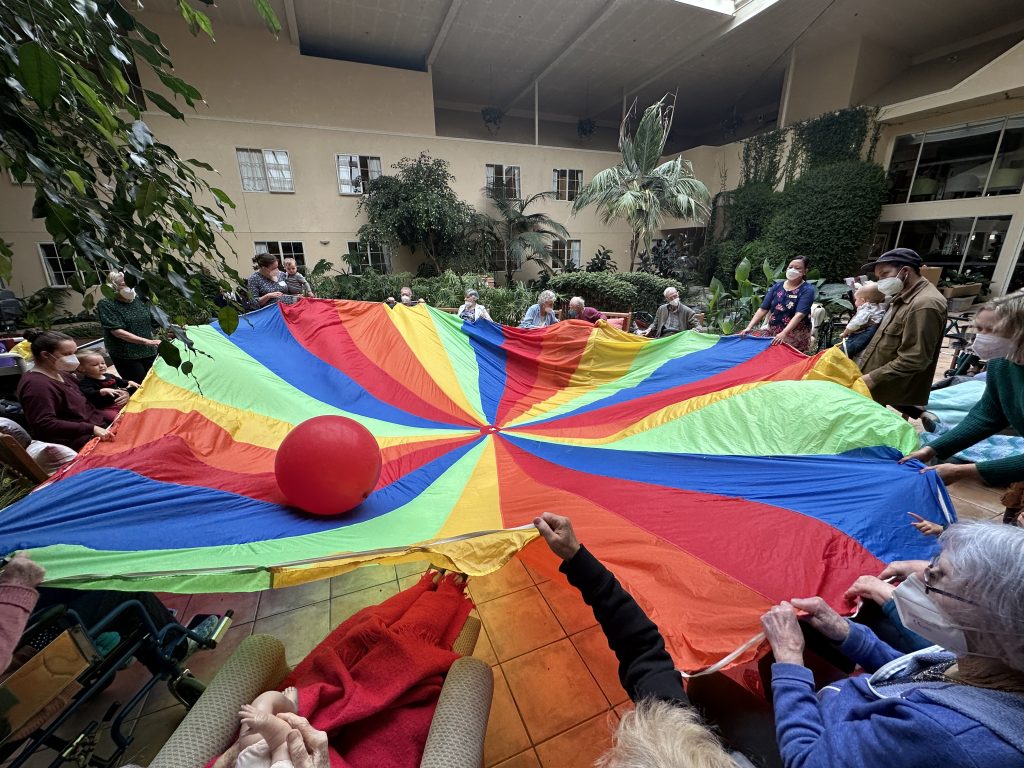

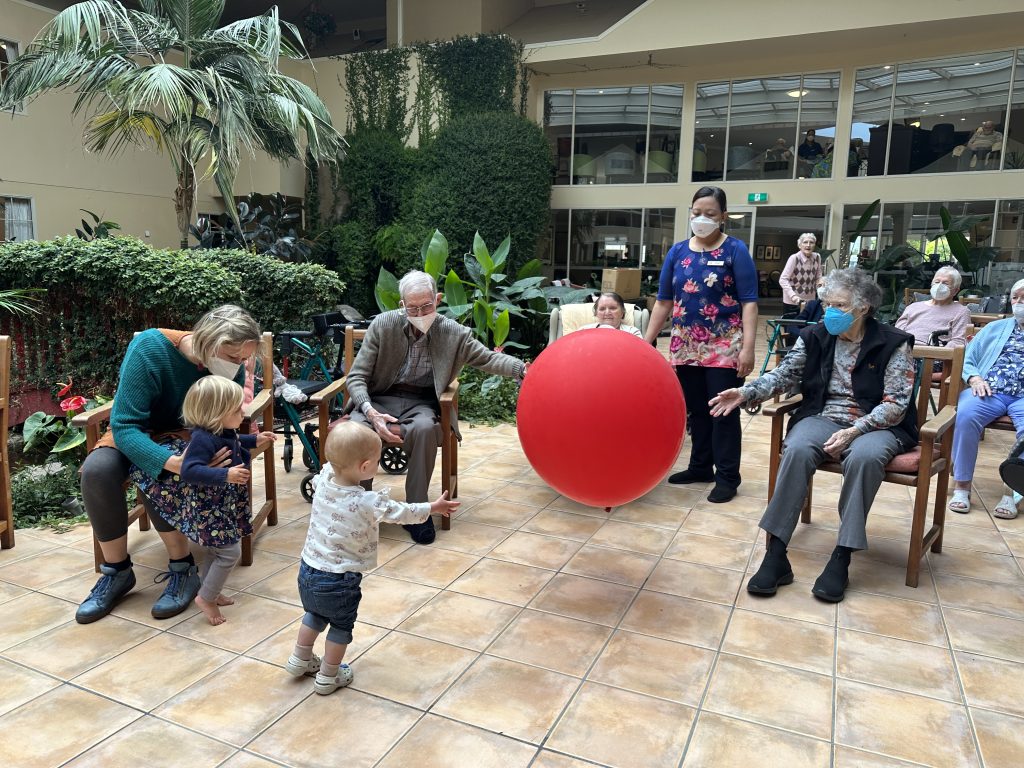
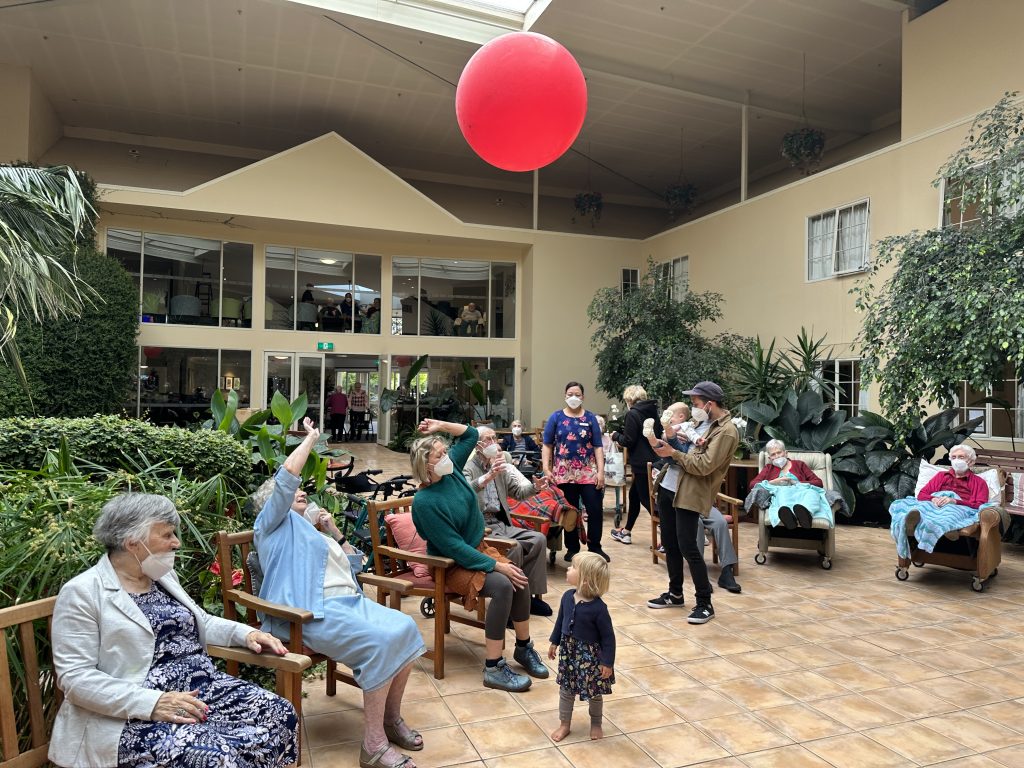
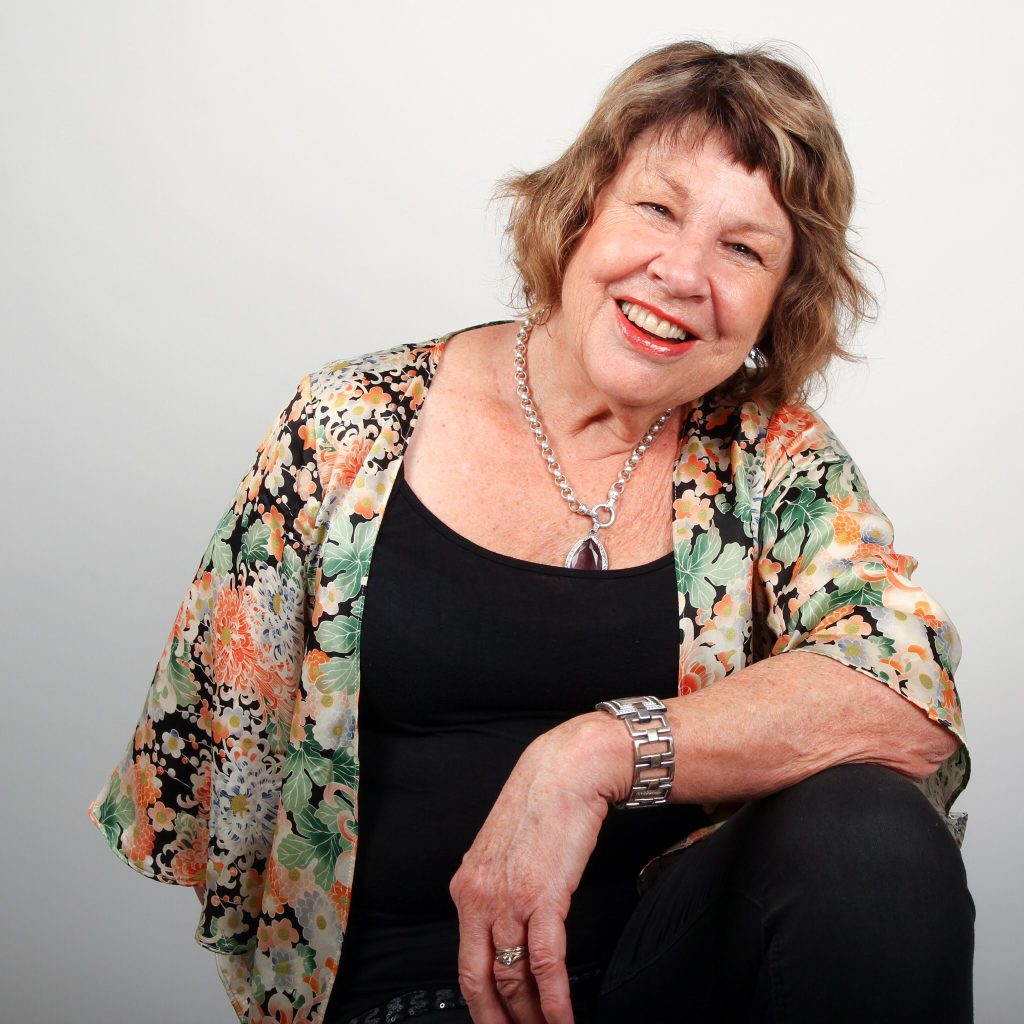
Julie Wylie MNZM founded the New Zealand Musical Parenting Association in 1992. She was the founder of the musical play programme at the Champion Centre, Burwood Hospital, Christchurch, New Zealand, where she was the senior music specialist for twenty eight years. Julie has been invited to present music workshops and papers in many countries, including Korea, Japan, Singapore, Australia, the United Kingdom, Lithuania, Estonia and Finland. She has received awards for her music leadership, and her music resources have won international awards. Julie was made a member of the New Zealand Order of Merit in the 2018 Queen’s Birthday Honours. She has her own music school for mothers and babies and children aged 0-8 years founded in 1990 and is the Director of the Postgraduate online training programme: “Certificate of Musical Play as Therapy”.
